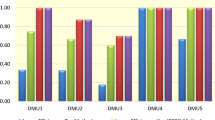Abstract
Several methods have been proposed in data envelopment analysis (DEA) for measuring efficiency in problems with interval or ordinal data. In this study, we review the weaknesses and drawbacks of these methods and show how converting ordinal or interval data into precise data can lead to violations of established DEA axioms. One of the axioms violated by these conversion processes is the inclusion of observations axiom, which requires a consistent definition of the production possibility set. We describe the special properties of ordinal and interval data together with their effect on the DEA-based rankings using a theorem and an example. We also propose a new algorithm and apply random dataset generation to overcome the problems arising from violations of the inclusion of observations axiom in DEA settings with ordinal or internal data. Several numerical examples are presented to demonstrate the applicability and exhibit the efficacy of the proposed method.

Similar content being viewed by others
References
Asosheh A, Nalchigar S, Jamporazmey M (2010) Information technology project evaluation: an integrated data envelopment analysis and balanced scorecard approach. Expert Syst Appl 37:5931–5938
Charnes A, Cooper WW, Rhodes E (1978) Measuring the efficiency of decision making units. Eur J Oper Res 2:429–444
Chen Y, Cook WD, Du J, Hu H, Zhu J (2015) Bounded and discrete data and Likert scales in data envelopment analysis: application to regional energy efficiency in China. Ann Oper Res. doi:10.1007/s10479-015-1827-3
Cooper WW, Park KS, Yu G (1999) IDEA and AR-IDEA: models for dealing with imprecise data in DEA. Manag Sci 45:597–607
Cooper WW, Park KS, Yu G (2001) IDEA (imprecise data envelopment analysis) with CMDs (column maximum decision making units). J Oper Res Soc 52(2):176–181
Cooper WW, Park KS, Yu G (2001) An illustrative application of IDEA (imprecise data envelopment analysis) to a Korean mobile telecommunication company. Oper Res 49(6):807–820
Despotis DK, Smirlis YG (2002) Data envelopment analysis with imprecise data. Eur J Oper Res 140:24–36
Farzipoor Saen R (2007) Suppliers selection in the presence of both cardinal and ordinal data. Eur J Oper Res 183:741–747
Kao C (2006) Interval efficiency measures in data envelopment analysis with imprecise data. Eur J Oper Res 174:1087–1099
Kao C, Liu ST (2009) Stochastic data envelopment analysis in measuring the efficiency of Taiwan commercial banks. Eur J Oper Res 196:312–322
Karsak EE, Dursun M (2014) An integrated supplier selection methodology incorporating QFD and DEA with imprecise data. Expert Syst Appl 41:6995–7004
Khalili-Damghani K, Tavana M, Haji-Saami S (2015) Data envelopment analysis model with interval data and undesirable output for combined cycle power plant performance assessment. Expert Syst Appl 42:760–773
Kim SH, Park CK, Park KS (1999) An application of data envelopment analysis in telephone offices evaluation with partial data. Comput Oper Res 26:59–72
Lee YK, Park KS, Kim SH (2002) Identification of inefficiencies in an additive model based IDEA (imprecise data envelopment analysis). Comput Oper Res 29:1661–1676
Marbini AH, Emrouznejad A, Agrell PJ (2014) Interval data without sign restrictions in DEA. Appl Math Model 38:2028–2036
Park KS (2004) Simplification of the transformations and redundancy of assurance regions in IDEA (imprecise DEA). J Oper Res Soc 55:1363–1366
Park KS (2007) Efficiency bounds and efficiency classifications in DEA with imprecise data. J Oper Res Soc 58:533–540
Park KS (2010) Duality, efficiency computations and interpretations in imprecise DEA. Eur J Oper Res 200:289–296
Toloo M (2014) Selecting and full ranking suppliers with imprecise data: a new DEA method. Int J Adv Manuf Technol 74:1141–1148
Toloo M, Nalchigar S (2011) A new DEA method for supplier selection in presence of both cardinal and ordinal data. Expert Syst Appl 38:14726–14731
Wang YM, Greatbanks R, Yang JB (2005) Interval efficiency assessment using data envelopment analysis. Fuzzy Sets Syst 153:347–370
Zhu J (2003) Imprecise data envelopment analysis (IDEA): a review and improvement with an application. Eur J Oper Res 144:513–529
Zhu J (2004) Imprecise DEA via standard linear DEA models with a revisit to a Korean mobile telecommunication company. Oper Res 52:323–329
Author information
Authors and Affiliations
Corresponding author
Ethics declarations
Conflict of interest
None.
Rights and permissions
About this article
Cite this article
Ebrahimi, B., Tavana, M., Rahmani, M. et al. Efficiency measurement in data envelopment analysis in the presence of ordinal and interval data. Neural Comput & Applic 30, 1971–1982 (2018). https://doi.org/10.1007/s00521-016-2826-2
Received:
Accepted:
Published:
Issue Date:
DOI: https://doi.org/10.1007/s00521-016-2826-2




